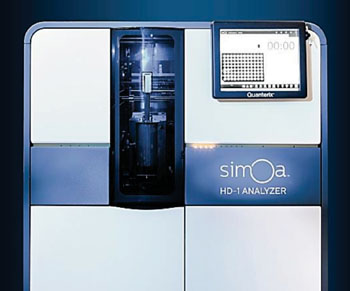Sensitive Analyzer Detects Blood Biomarker for Traumatic Brain Injury
By LabMedica International staff writers
Posted on 19 Aug 2015
Traumatic brain injury (TBI) is recognized as the signature injury in military personnel deployed for combat operations, and combat injuries and injuries in non-deployed settings have resulted in more than 300,000 TBI cases, with many experiencing multiple TBIs.Posted on 19 Aug 2015
Tau is a microtubule-associated protein that functions as a structural element in the axonal cytoskeleton and elevations of tau concentration are an indication of axonal injury and are observed in the cerebral spinal fluid and peripheral blood of patients with severe TBI, professional boxers, and concussed athletes.

Image: The Single Molecule Array (Simoa) HD-1 Analyzer (Photo courtesy of Quanterix Corporation).
Scientists at the National Institute of Nursing Research, (NINR; Bethesda, MD, USA) and their colleagues carried out an observational assessment from September 2012 to August 2014 on 70 military patients with self-reported TBI and compared their tau concentrations in blood plasma to a control group consisting of 28 subjects. Non-fasting blood samples were collected into plastic dipotassium EDTA tubes, placed on ice, and centrifuged at 2,000 × g for 15 minutes at 4 °C, and plasma was aliquoted.
Tau concentrations in plasma samples were measured with a digital array technology (Quanterix Corporation; Lexington, MA, USA), which uses a single-molecule enzyme-linked immunoarray (Simoa) method. The Simoa Human Total Tau assay uses a combination of a monoclonal capture antibody that reacts with a linear epitope in the mid-region of all tau isoforms, and a detection antibody that reacts with a linear epitope in the N-terminus of total tau. The limit of detection for this assay is 0.012 pg/mL.
A significantly elevated concentration of total tau with a mean of 1.13 ± 0.78 pg/mL was found in the self-reported TBI group compared with the control group whose mean was 0.63 ± 0.48 pg/mL. Within the self-reported TBI cases, plasma total tau concentrations were significantly associated with having a medical record of TBI compared with self-reported TBI only. The severity of total post concussive symptoms correlated with total tau concentrations in the self-reported TBI group. They also found that participants with three or more deployment-related TBIs had significantly higher levels of tau compared with participants who had fewer TBIs.
The authors concluded that increases in total tau concentration in the peripheral blood in military personnel with multiple TBIs and chronic post concussive disorder (PCD) symptoms suggest that tau accumulations may contribute to chronic neurological symptoms following TBI. E. Kevin Hrusovsky, PhD, CEO of Quanterix Corporation, said, “This is one of the many studies in which Simoa is being used to further understand and quantify the long term effects of TBI and we are pleased to be working with NINR to continue our mission to understand what is going on in the human body and, in turn, improve the quality of care.” The study was published on August 3, 2015, in the journal JAMA Neurology.
Related Links:
National Institute of Nursing Research
Quanterix Corporation




 assay.jpg)








